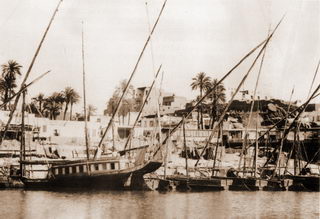
Débarquadère à Assouan, circa 1887.
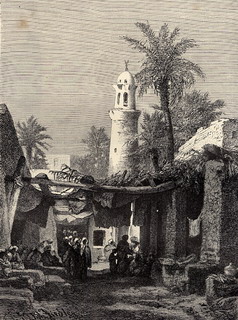
Un bazar à Assouan en 1876.
Ebers.
Assouan

Débarquadère à Assouan, circa 1887. |

Un bazar à Assouan en 1876. |
|
Hachem,
un jeune homme d'Assouan, en 1876. |
 L'un des débarcadère
d'Assouan, en 1876. |
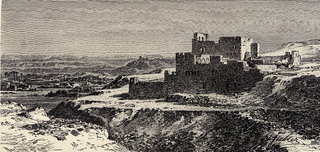
Un couvent chrétien,
abandonné, aux environs d'Assouan, en 1876. |
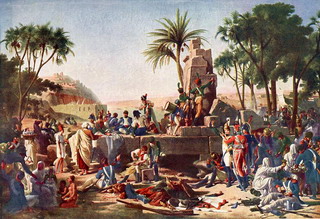
L'armée de Bonaparte campant à Assouan en 1800. D'après Tardieu. |
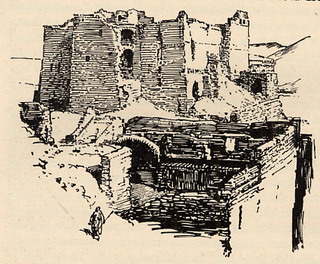
Couvent Saint Syméon, près d'Assouan. Circa 1931. |
Couvent Copte près de Philae. Circa 1931 Détail. |

Couvent Copte près de Philae. Circa 1931 Détail. |
Une vision du Cataract Hotel en 1935. |
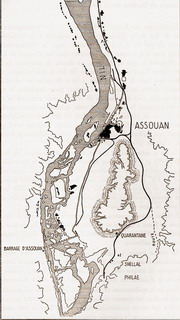
Plan d'Assouan et de ses environs en 1931. |

Le Nil et le Temple submergé de Philae en 1931. |
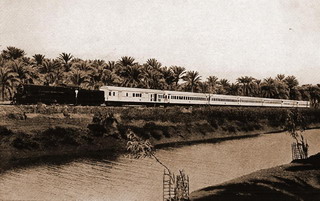
L'express Le Caire à Assouan. |
Assouan 1938. Le Roi Farouk, salué à son arrivée à Assouan par l'Hymne Royal. Le souverain s'y rend pour inaugurer la seconde élévation du Barrage. |
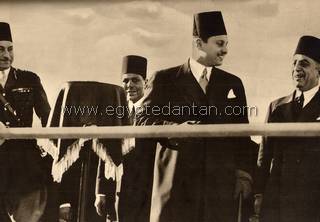
A Assouan, en 1938 le Roi Farouk entouré de Hussein Sirry Pacha et Mohamed Mahmoud Pacha inaugure la seconde surélévation du Barrage d'Assouan. |
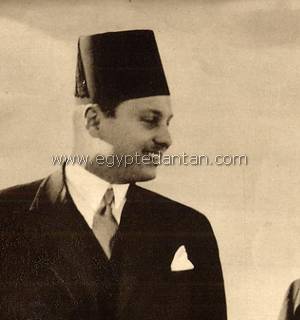
A Assouan en 1938, le Roi Farouk inaugurant la seconde surélévation du Barrage. Détail. |
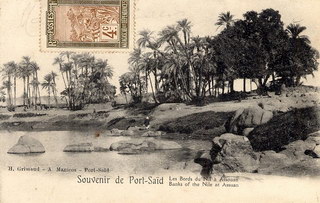 Bord du Nil à Assouan vers 1912.Cliché H. Grimaud et A. Manicos. |
 Intéressant document qui montre l'un des côté de l'hôtel Cataract à Assouan avant le construction du grand dôme du restaurant. Circa décembre 1899/1902. Nous remerçions Monsions Cornelius von Pilgrim pour ses éclaircissments concernant ce document. |

Plan de localisation de la pension Neufeld à Assouan vers 1910. Courtoisie de Messieurs Phil Lloyd et Stephan Rudloff. |
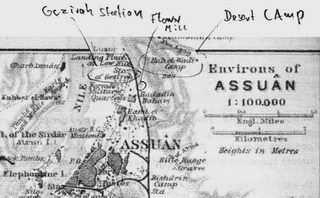
Plan de localisation du moulin Neufeld vers 1910. Neufeld possedait également un camp désertique appelé "Bal el Wadi Camp" qui se trouvait tout près du moulin. Courtoisie de Messieurs Phil Lloyd et Stephan Rudloff. |
|
Deux jeunes bicharines. Circa 1913. Cliché L.L. 59 (Egyptian types and scenes).
|
Groupe de crocodiles à Assouan vers 1897. |
| Obituary on Carl Neufeld, in: Der Neue Orient (The
new Orient periodical of the German Foreign Office, Volume No. 3, of
30. July 1918, pages 391-392 Carl Neufeld The German trader Karl Neufeld, who was famous as the “Prisoner of the Mahdi”, died in a hospital near Berlin aged little more then 60 years. On his adventurous life, we hear the following from his family: Carl Neufeld was born on 4th August 1856 in Damerau, district Kulm. His father was a medical doctor. After attending the Real gymnasium in Bromberg, he studied medicine in Leipzig and Königsberg. As after the fall of the Falk minister, people who had attended only a Real gymnasium, were not longer allowed to study medicine, he quit his studies. At first he wanted to join a survey expedition bound for Japan, went instead in 1875/76 to Constantinople, were he worked for a bookseller. Half a year later we find him in Alexandria. Here he married in 1877 a some years older British lady. The marriage was very unsuccessful. As his wife stayed in Alexandria, he took to longer journeys. So he was medical doctor on a cable steamer between Aden and Bombay, later for a time medical doctor with the Copts in Upper Egypt. During the Mahdi wars, he worked for the British, first as “Dragoman” later as a contractor for the British Army. He made barracks for the troops and did the forts between Aswan and the Sudan. After the British had left the Sudan he stayed as a trader in Aswan, and in 1886 he equipped a caravan to collect gum and ivory in the Sudan, which was now not possible. He went with an Arabian sheik who fought against the Mahdi. On his way in the Sudan, he was ambushed by followers of the Mahdi, all his companions were killed. Neufeld was taken to Omdurman, were he stayed for twelve years in chains. Three years he was not allowed to leave his prison, an Arab black hole. Later he had to do different things for the Mahdists. So he had to do the model for the Mahdis tomb, had to make powder, repair the rifles and construct coining machines, had to work as a medical doctor. His knowledge’s was taken advantage in every way. Despite this he had to wear chains (around 60 pounds of them) and was beaten, had not enough to eat. Some unsuccessful near escapes made it even worse and he was strongly guarded. After Kitchener had won the battle at Omdurman on the 2nd December 1898, he himself freed Neufeld from prison and took of his chains. Neufeld always said that this day was his second birthday. At first he was in low spirits, and he had no money, as the money which had been collected for him was not given to him. He stayed for a year in Egypt and went then to England, were he made lectures on his adventures. Around 1900 he came to Germany and went in 1902 back to Egypt, were he made a traders business and sold especially German machines all over Egypt. Shortly afterwards, his sister Margarete joined him and he lived with her up to 1912 in Aswan. Then he settled in Omdurman. At the beginning of the war, the British authorities expelled him and he went back to Germany. Here he gave his knowledge for eventual expeditions into the Orient. In 1915 he was send on important mission to Arabia, to try to come to Abyssinia. But due to the revolt of Hussein of Mecca this was not possible. He there worked for the German cause in Turkey. In autumn 1917 he joined the auxiliary forces and worked with the “Niederlegungskommission” in Belgium as a civil engineer. Here he developed disease of the bladder and the kidney, later got pneumonia and died on the 2nd July 1918. For the Mohammedans he was Sheik Abdallah, and his German name of Neufeld was made into the Arabic Naufel. On his adventures he has written a book, “In Ketten des Kalifen” which was published by Speemann in Stuttgart. Courtoisie de Messieurs Phil Lloyd et Stephan Rudloff. |
|
|
Réservoir d'Assouan. Cliché Handras . C.1912. |
Les ânieres de Karnak attendent les touristes. C.1909. Cliché LL Karnak 1918. |
.jpg) Les ânieres de Karnak attendent les touristes. C.1909. Cliché LL Karnak 1918. |
Les ânieres de Karnak attendent les touristes. C.1909. Cliché LL Karnak 1918. |
|
Les ânieres de Karnak attendent les touristes. C.1909. Cliché LL Karnak 1918. |
Vu prise depuis le Cataract Hotel à Assouan vers 1908. Cliché L.L., Asouan Nr 13. |
|
Musiciens d'Assouan en 1905. |
Assouan et le Cataract Hotel en 1904. |
|
Les rives d'Assouan en 1904.
|
Mosquée à Assouan en 1904. |
|
L'île Eléphantine en 1904. |
L'île Eléphantine en 1904. |
|
L'île Eléphantine en 1904. |
|
 Sur les rives du Nil à Assouan vers 1910. |
|
 Guerriers Bicharine à Assouan vers 1899. Cliché F. Kharidiache. |
|
 Vue générale d'Assouan et du Grand Hôtel |
|
 Vue générale d'Assouan et du Grand Hôtel (détail) |
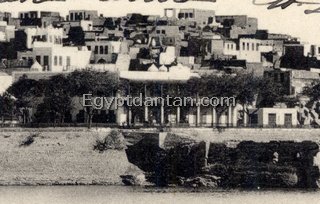 Vue générale d'Assouan et du Grand Hôtel (détail) |
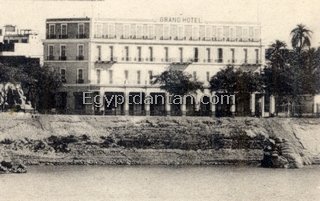 Le Grand Hôtel (détail) |
|
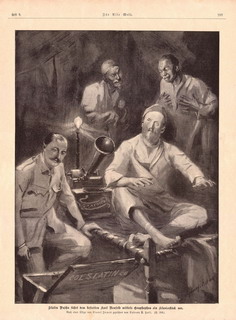
This picture was published in the German magazine "Für Alle Welt" in about 1899. It was drawn by Sydney Prior Hall, after a sketch by Lionel James, and shows two ex-prisoners of the Mahdi, Slatin Pasha and Carl Neufeld. Its title translates as "With a gramophone, Slatin Pasha plays a piano piece for the liberated Karl Neufeld" Picture courtesy of Phil Lloyd. |
|